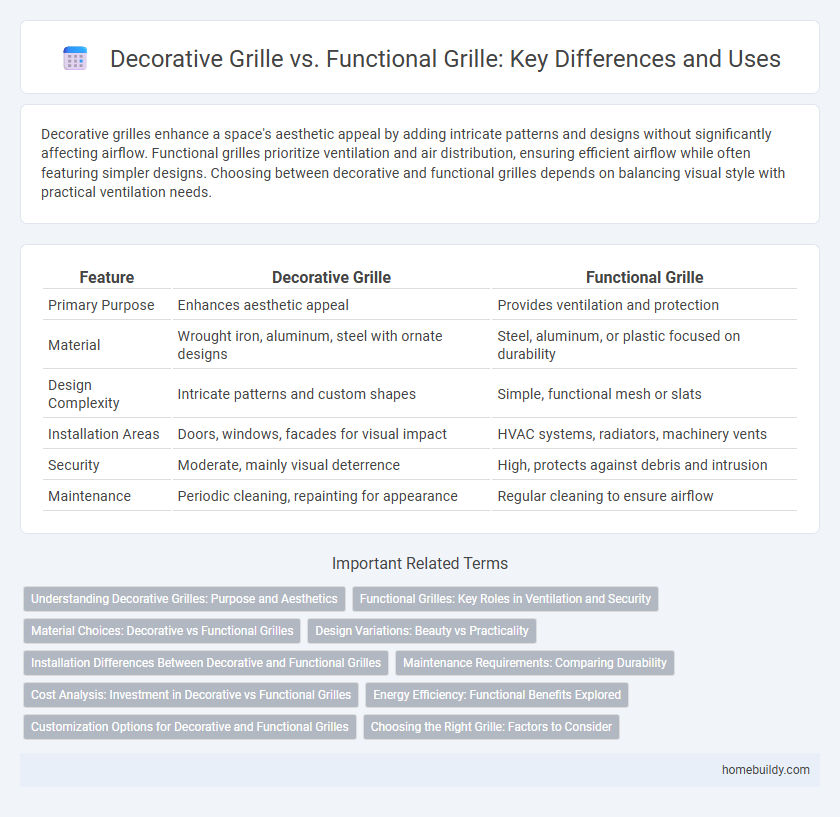Decorative grilles enhance a space's aesthetic appeal by adding intricate patterns and designs without significantly affecting airflow. Functional grilles prioritize ventilation and air distribution, ensuring efficient airflow while often featuring simpler designs. Choosing between decorative and functional grilles depends on balancing visual style with practical ventilation needs.
Table of Comparison
| Feature | Decorative Grille | Functional Grille |
|---|---|---|
| Primary Purpose | Enhances aesthetic appeal | Provides ventilation and protection |
| Material | Wrought iron, aluminum, steel with ornate designs | Steel, aluminum, or plastic focused on durability |
| Design Complexity | Intricate patterns and custom shapes | Simple, functional mesh or slats |
| Installation Areas | Doors, windows, facades for visual impact | HVAC systems, radiators, machinery vents |
| Security | Moderate, mainly visual deterrence | High, protects against debris and intrusion |
| Maintenance | Periodic cleaning, repainting for appearance | Regular cleaning to ensure airflow |
Understanding Decorative Grilles: Purpose and Aesthetics
Decorative grilles serve primarily to enhance architectural aesthetics, featuring intricate designs and diverse materials that complement interior and exterior styles without compromising airflow. These grilles often incorporate patterns such as geometric shapes, floral motifs, or custom artwork, transforming functional elements into visual focal points. Their purpose lies in blending ventilation needs with ornamental appeal, making spaces both practical and visually engaging.
Functional Grilles: Key Roles in Ventilation and Security
Functional grilles play a crucial role in ventilation by allowing air to circulate efficiently while blocking debris and pests, ensuring optimal indoor air quality. They enhance security by providing a robust barrier that prevents unauthorized access without compromising airflow. Designed with durable materials and strategic patterns, functional grilles balance safety and ventilation needs in residential and commercial settings.
Material Choices: Decorative vs Functional Grilles
Decorative grilles often utilize materials like wrought iron, brass, or aluminum to enhance aesthetic appeal while offering moderate durability. Functional grilles prioritize materials such as stainless steel, galvanized steel, or heavy-duty aluminum to ensure strength, corrosion resistance, and security. Material choice directly impacts performance and visual appeal, with decorative grilles balancing style and function, whereas functional grilles emphasize practicality and longevity.
Design Variations: Beauty vs Practicality
Decorative grilles prioritize intricate design variations that enhance aesthetic appeal, often featuring ornate patterns and customizable finishes to complement architectural styles. Functional grilles focus on practicality through streamlined designs that maximize airflow, durability, and ease of maintenance, often utilizing materials like aluminum or steel for strength. Balancing beauty and practicality, some grilles integrate elegant motifs without compromising ventilation efficiency or structural integrity.
Installation Differences Between Decorative and Functional Grilles
Decorative grilles prioritize aesthetic appeal and are often designed for easier installation using surface-mounting techniques, allowing them to be added without altering existing structures. Functional grilles require precise fitting within ducts or vents for optimal airflow control, typically involving more complex installation methods such as mounting within drywall or integrated ductwork. The installation complexity of functional grilles demands professional expertise to ensure both performance efficiency and compliance with ventilation standards.
Maintenance Requirements: Comparing Durability
Decorative grilles often require more frequent cleaning and gentle upkeep to preserve their aesthetic appeal, as materials like wrought iron or aluminum can be prone to chipping or fading over time. Functional grilles, designed primarily for airflow and protection, typically feature durable materials such as steel or reinforced plastic, offering greater resistance to wear, corrosion, and environmental damage. Regular maintenance for functional grilles usually involves simple inspections and occasional cleaning, whereas decorative grilles may demand periodic refinishing or repainting to maintain their visual integrity.
Cost Analysis: Investment in Decorative vs Functional Grilles
Decorative grilles typically involve higher upfront costs due to intricate designs and premium materials, making them a significant investment for aesthetic enhancement. Functional grilles prioritize durability and utility, often resulting in lower initial expenses but potentially higher maintenance costs over time. Evaluating long-term value, functional grilles may offer cost efficiency, while decorative grilles add architectural appeal that can increase property value.
Energy Efficiency: Functional Benefits Explored
Functional grilles improve energy efficiency by optimizing airflow and reducing heat loss or gain through ventilation systems, directly impacting HVAC performance. Decorative grilles primarily serve aesthetic purposes and may not offer the same level of air regulation, potentially compromising energy conservation. Utilizing functional grilles designed with precise airflow control enhances indoor climate management and lowers energy consumption.
Customization Options for Decorative and Functional Grilles
Decorative grilles offer extensive customization options including intricate patterns, diverse materials, and various finishes that enhance aesthetic appeal, allowing tailored designs to complement architectural styles. Functional grilles prioritize customization for airflow efficiency, material durability, and safety features, with options such as adjustable louvers, corrosion-resistant coatings, and protective mesh. Both types can be adapted in size and shape to meet specific environmental and design requirements while balancing style and performance.
Choosing the Right Grille: Factors to Consider
When choosing the right grille, consider the purpose: decorative grilles prioritize aesthetic design and material finish, enhancing architectural appeal, while functional grilles focus on airflow efficiency, durability, and protection against debris. Evaluate factors such as ventilation requirements, environmental exposure, and maintenance needs to ensure optimal performance and longevity. The choice between decorative and functional grilles depends on balancing design preferences with practical functionality for the intended application.
Decorative Grille vs Functional Grille Infographic

 homebuildy.com
homebuildy.com